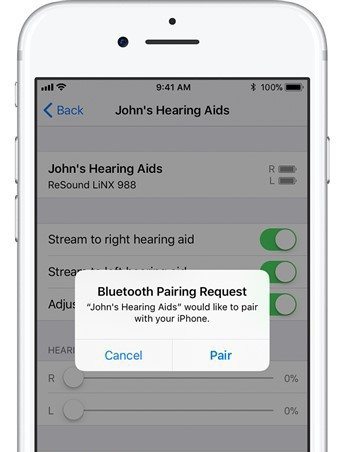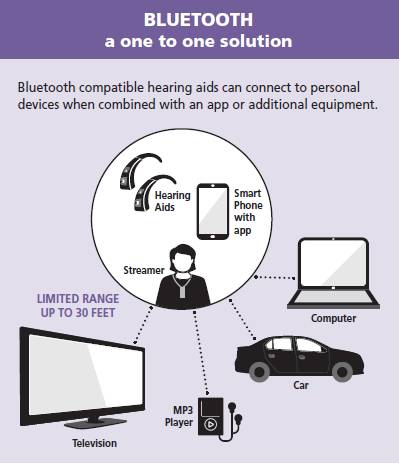Hearing aid design and performance took a giant leap with the arrival of new hearing aid technology. Till then, hearing aid users had little choice but to use bulky hearing aids with very limited sound adjustment controls and user-friendly features.
These limitations made hearing aids unpopular and people were reluctant to use them. Effectively, new technology in hearing aids started with the introduction of digital electronics. The progress made in the last few years has been amazing. Let us get familiar with the latest technology in hearing aids and how they benefit the users.
Table Of Contents
- What Are Bluetooth Hearing Aids?
- How Do Bluetooth Hearing Aids Work?
- What Is An AI Hearing Aid?
- Rechargeable Hearing Aids
- What’s The Newest Technology In Hearing Aids?
What Is The Latest Technology In Hearing Aids?
In this blog, we will be covering the latest technology in hearing aids which have made a big difference in the hearing aid user’s listening experience. Introduction of new hearing aid technology with the following features has increased the comfort level of the hearing aid users.
- Bluetooth Hearing Aids
- AI Hearing Aids
- Rechargeable Hearing Aids
- Hearing Aid Apps
What Are Bluetooth Hearing Aids?
Digital hearing aids with Bluetooth wireless communication technology are known as Bluetooth hearing aids. The Bluetooth technology connects two devices wirelessly. Both the devices should be ideally within ten meters or 33 feet of each other.
Modern hearing aids use BLE or Bluetooth Low energy that consumes very little power, which is ideal for hearing aids working on button cells.
How Do Bluetooth Hearing Aids Help The User?
The popularity of mobile phones and phasing out of landlines created a problem for hearing aid users. The conventional digital hearing could not pick up the voice of the person at the other end.
The hearing aid starts humming and buzzing if the mobile phone is anywhere close to it. Bluetooth hearing aids solved this problem and the hearing aid users could converse on the mobile phone.
How Do Bluetooth Hearing Aids Work?
Connecting two devices is known as pairing, we have to pair or connect the two devices we intend to use.
We can connect the Bluetooth hearing aid to a smartphone, The Apple, iPhone, and most Android smartphones can be paired or connected.

The procedure is very simple.
- Switch on the Bluetooth mode of your hearing aid as well as your smartphone.
- The smartphone will search for Bluetooth devices in its range. It will detect the devices and display the device names.
- Select the one you want and you are ready to use.
- When you receive a call on your mobile phone, you will see options on your smartphone screen, select Bluetooth, and the voice will be streamed to your ears.
There is no need to take the phone near your hearing aids. The voice is clear without any external disturbances. Read our blog on Bluetooth hearing aids to know more.
The Bluetooth connectivity is not restricted to smartphones, you can connect any device which has a Bluetooth option.
Music lovers can listen to their favourite tunes as most personal listening devices like the iPod or MP3 devices have Bluetooth connectivity.
Many brands offer external streaming devices, these devices connect to the television to send audio. This eliminates the problem of increasing the TV volume and disturbing everyone in the room.

Connect your Bluetooth hearing aid to your laptop and participate in Zoom and online web meetings.
Bluetooth hearing aids are very popular and are available in an affordable price range.
What Is An AI Hearing Aid?
The ability of the hearing aid to make intelligent decisions or copy human thinking to perform a set of tasks is known as AI or Artificial Intelligence.
AI hearing aids are also known as smart hearing aids or Artificial intelligence hearing aids. This feature is the latest technology in hearing aids, these hearing aids can also connect to the Internet.
What Are The Benefits Of AI Hearing Aids?
Since the AI hearing aid behaves as a human being would, it automatically performs actions that a user would do manually.
A major problem a hearing aid user faces is listening to speech in a noisy environment or among a group of people. The hearing aid user has to strain to pick up the voice he or she wants to hear among other voices or sounds. The AI hearing aid can solve this problem to a large extent.
The computer in the hearing aid analyses the sound picked up by the hearing aid. It determines the speech which is important and highlights it by suppressing other sounds. This helps the user to understand and converse without missing the conversation.
The AI hearing aid also collects and stores data on the user’s listening pattern. The user can move from a quiet room to a noisy street without manually changing the settings. The hearing aid will detect and tune itself to the new situation.
If you switch on the television, the AI hearing aid will automatically enhance the TV volume. If you are talking to a male or a female, the hearing aid will automatically make frequency adjustments to enhance the speech.
The AI hearing aid can also memorize your spouse’s or the voice of the person you talk to the most, it will prioritise and enhance this particular voice if others are talking in a group.
AI Hearing aids can now also track your health parameters and send a warning message to a preselected contact number in case there is a serious health issue.
A useful feature for elders who stay alone is the fall detection feature, in case of a fall, a message is automatically sent for help.
Internet connected hearing aids can connect to other internet connected devices. Internet doorbells and fire alarms are wirelessly connected to the hearing aid. The deaf can hear the doorbell ring or the fire alarm going off and take appropriate action.
It is possible to program the Internet connected hearing aids to notify the user if a message or mail is received.
Rechargeable Hearing Aids
Hearing aid batteries are an important accessory of a Hearing aid. Most of the hearing aid users buy disposable Hearing aid batteries. These batteries are inconvenient and need regular replacement. What if we could insert the hearing aid battery once and forget about it? Yes, it’s very much possible. Rechargeable Hearing aids are now the preferred option.
Let us find out the negative aspects of disposable batteries and why users prefer rechargeable hearing aids.
- It is difficult for elders with unsteady hands to insert the battery in the hearing aid compartment. They have to depend on others to insert/remove the battery.
- The battery tends to fall out of the compartment. It invariably rolls to the most inconvenient places and is never found. The user has to insert a new battery which increases expenses.
- Bluetooth hearing aids consume more power if streaming is regularly used. The user has to replace the battery more often.
- Hearing aid users have to stock up on batteries as they may suddenly run out leaving them helpless.
- Disposable batteries start working on the removal of the colored plastic tab, even if they are not inserted in the hearing aid.
- The Hearing aid user has to make repeated trips to the seller to buy batteries. This is a major inconvenience for the elderly who stay alone.
- Since these are disposable batteries, they are not environment-friendly as they are not recyclable.
- Repeated cost is another factor. A small size 312 battery works for less than a week. One needs to buy a minimum of 52 batteries every year.
- One has to be particular about the positive and negative side of the battery while inserting it. A wrong insertion can break the battery compartment resulting in repairs and inconvenience.
How Long Do Rechargeable Hearing Aids Last?
Rechargeable hearing aid batteries last for over 24 hours for every full charge. It finally depends on the usage, in case, if it’s used only for speech and not too much streaming, it may last more.
Companies offer portable charging devices that can be plugged into any electrical outlet or can charge the hearing aid using a laptop USB port. Read our blog on Rechargeable Hearing aids to know more.
What’s The Newest Technology In Hearing Aids?
The newest technology in hearing aids is:
- Online hearing aid programming
- Self-fitting hearing aids
All these functions can be done by using an app for hearing aid.
Online Hearing Aid Programming
Online hearing aid programming, also known as Remote Hearing Aid programming is a very useful feature. Manufacturers of hearing aids provide a smartphone app for hearing aid. The hearing aid app connects to the hearing aid and it’s possible to make minor adjustments like tone and volume as required by the user.
In case, the user is not satisfied with the settings, they can contact their dispenser and explain the problem. The dispenser will connect online through the hearing aid app and reprogram the hearing aid to the users satisfaction. This feature is a very useful for people who are not mobile, stay far from the dispenser, and during lockdowns.
Self-Fitting Hearing Aids
Self-fitting is the latest technology in hearing aids. Bose Corporation is the first company to obtain FDA clearance to market its self-fitting hearing aid. The Bose SoundControlTM is sold on the following conditions:
• Not meant for people under 18 years of age
• Only for Mild to Moderate loss
• Does not take phone calls or stream music
This category of hearing aids is known as Over the Counter hearing aids or OTC hearing aids. It is advisable for people with severe to profound hearing loss to visit the audiologist for complete diagnosis and fitting.
Hearing loss can be arrested with early diagnosis and the use of hearing aids. Scientific studies prove that unattended hearing loss leads to depression and dementia. The risk of dementia doubles in case of unattended mild hearing loss and increases five times in case of severe hearing loss1.
Do not delay the use of hearing aids. With the latest technology in hearing aids, they are user-friendly, have multiple features to adapt to all situations, and are practically invisible.
